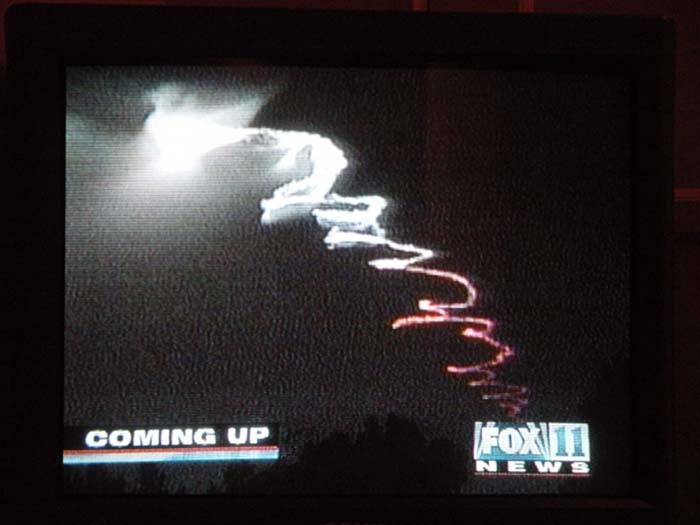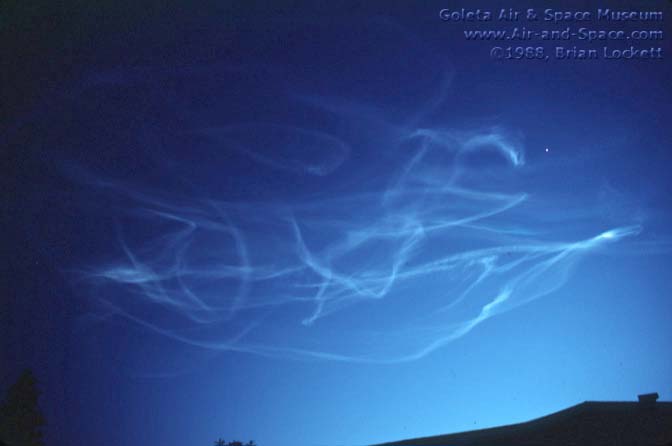So - did anyone ever figure out what was launched in California and why?
Yes, it wasn’t a missile. It was a vapor trail from a plane.
Most peculiar. So many experts said that wasn’t it, and so many experts said it was clearly some sort of missle. Any good citations or source material on the final determination?
Link - it’s a jet.
It was very obviously an airplane from the images I saw, it was just at an odd angle with the sun and clouds, etc. At first glance it sure looked like a missle, but after watching it for a few seconds it is moving waaaayyyy to slow to be a missle. When the video was enlarged it clearly was an airplane.
And here’s a pretty thorough analysis of the situation that had me convinced, too, that it was a plane.
Can you point to an ‘expert’ who said it was a missile?
I guess I’d start with Robert Elsworth, a former deputy Secretary of Defense. He said, “It is a big missle.”
Not in that story he didn’t.
listen to the vid, Map.
Very lame explanation. The US test fires submarine launched ballistic missiles quite frequently, it isn’t like a show of force is necessary. It is even more implausible that we would fire a missile from the Pacific and aim it at Arizona.
It was clearly and airplane, and Mr. Ellsworth clearly didn’t know what he was talking about.
A quick look at the Wiki on Elsworth doesn’t show any expertise in identifying missiles and aircraft vapor trails. He doesn’t offer any technical description of the event.
(bolding mine)
We have the definitive answers from the military and other sources now. It wasn’t a missile, it was a plane.
The aircraft I’ve flown don’t go high enough to make contrails, and my missile experience is in processing radar cross-section data; so take this for what it’s worth.
I’ve seen a buttload of contrails in my life, and several missile trails from Vandenberg AFB launches. Missile trails look more like these than the one in the OP:

http://www.alaska-in-pictures.com/data/media/13/rocket-trail_1113.jpg

http://prophecycorner.theforeverfamily.com/miniteman3missile-very%20best9-19-02.jpg
.
Why are they all wiggly?
Winds are at different directions and speeds at different altitudes. Check out this chart:
000
FDUW02 KWBC 301359
DATA BASED ON 301200Z
VALID 301800Z FOR USE 1700-2100Z. TEMPS NEG ABV 24000
FT 3000 6000 9000 12000 18000 24000 30000 34000 39000
BIH 9900 3506+11 3312+07 3126-05 3032-17 313434 303944 293754
BLH 3506 2811+19 2421+16 2323+10 3015-04 3119-18 321334 361743 331952
FAT 9900 3508+14 3412+13 3315+09 3022-05 3027-17 303034 293744 293654
FOT 3615 3412+10 3011+08 3022+05 2946-08 2855-20 275936 276546 277854
ONT 9900 0912+19 9900+15 9900+11 2812-04 3213-18 341733 342043 322753
RBL 3406 9900+12 2808+09 3019+06 2937-07 2846-19 275135 275445 286554
SAC 3611 9900+14 3009+10 3215+08 3026-06 2928-18 283935 284144 284654
SAN 9900 9900+21 2310+17 2307+11 2908-04 3608-18 361333 021942 321352
SBA 9900 0608+18 0409+15 3611+10 2908-04 3414-18 341534 321843 312754
SFO 0406 3206+14 3114+11 3215+09 3120-06 2924-18 283534 283844 284254
SIY 9900+08 2712+05 2821+03 2845-09 2863-21 276837 277446 278554
WJF 0813+17 9900+14 3408+10 2815-04 3215-18 331834 322343 323054
AST 2511 2514+01 2515-02 2624-03 2737-14 2851-27 286043 277450 278052
IMB 2418-01 2521-01 2735-13 2749-25 278338 279447 279154
LKV 2516+03 2723+02 2844-09 2863-21 277036 277546 288254
OTH 2705 9900+02 2816+04 2825+01 2843-12 2866-23 278738 278947 279654
PDX 2309 2613+02 2718-03 2625-02 2835-14 2847-26 286143 278049 278652
RDM 2514+05 2515+01 2623+00 2838-13 2853-24 278638 279447 279454
GEG 2421+03 2523+00 2523-04 2537-16 2644-28 255444 266051 266250
SEA 2210 2520+01 2619-05 2627-05 2742-15 2752-28 286445 277051 276751
YKM 2808 2810+03 2618+00 2525-03 2735-15 2748-27 275844 276850 277351
The top row of data is the altitude (MSL up to 12,000 ft, pressure altitude above that). The first column is the reporting station; for example, WJF is William J. Fox Airfield in Lancaster, CA. The 3,000 ft column is blank for WJF because the field elevation is 2,347 ft and winds are not given within 1,500 feet of field elevation. (Temperatures are not given for the first 2,500 feet AGL.) The first pair of numbers is the wind direction. For example, the winds at BLH at 6,000 feet are blowing from 280º. The second pair of numbers is the speed. The winds at 6,000 feet at BLH are blowing at 11 knots. The sign and the next two numbers are the temperature in ºC. (Note: All temps are negative above 24,000 feet.)
So reading across the row for BLH we see that the winds are from 350º, 280º, 240º, 230º, 300º, 310º, 320º, 360º, and 330º; and that their speeds vary from 6 knots to 23 knots. (Oh – 9900 means winds are ‘light and variable’.)
When an airplane makes a contrail, they are generally at a constant altitude. Winds will vary over time and make the contrail ‘wiggle’ a bit, but the contrails are pretty much straight. A missile goes from ground level to outside of the atmosphere, so it passes through many regions of differing wind directions and speeds. Thus the trail is perturbed more than contrail are.
Planes tend to fly at a more or less constant altitude where the wind speed and direction doesn’t vary much, so the whole contrail moves with the wind as it disperses. Ballistic missiles, sounding rockets, and space launch vehicles tend to fly up, gaining altitude much faster than any aircraft, and experience strong wind shear due to high gradients of wind motion at altitude, which often leaves a jagged looking plumetrail. In addition, solid rocket motors and storable liquid engines have a variety of heavier combustion products that separate out from the water vapor and disperse at different rates, so you get more diffusion and differentiation than the water vapor trails contrails left by aircraft.
Some solid rockets also perform energy wasting “French Horn” maneuvers like this, giving a radical spiral. This is done to get rid of excess energy that is not needed to achieve the pierce point or intercept and prevent overshoot.
Stranger
[QUOTE=Stranger On A Train]
Some solid rockets also perform energy wasting “French Horn” maneuvers like this, giving a radical spiral. This is done to get rid of excess energy that is not needed to achieve the pierce point or intercept and prevent overshoot.
Stranger
[/QUOTE]
Pardon my ingnorance, but can’t they just put less fuel on the rocket in the first place?
Rocket fuel must be expensive after all…
Solid rockets can’t really be throttled. (Spaceship One’s, and maybe a few others’ excepted) Once you light them, they stay lit. I don’t know if you can even vary their burn rate once lit. And you can’t launch them with only, say, half of the propellant. IIRC, most of them are sealed units when they come from the factory. Modifying a solid rocket propellant column—by fluting it, or sawing off half of it—I think would be a good way for Very Bad Things to happen to your rocket.
So, if the rocket finds itself going too fast to make it’s intercept, it needs to shed energy somehow. Hence the twists linked to by Stranger. (That a Patriot launch, BTW? It looks like the tell-tale debris from the container at the launch point.)
I kinda figured solid fueled rockets can’t be throttled, but I assumed each rocket is built to order. (I was also thinking about surface to orbit rockets for satellite launches, and completely forgot about the ton of various weaponised rockets.) I figured you could tell the manufacturer to provide one with less fuel in it.
You’ve learned an important lesson, young Jedi. Never rely on videos for your news. ![]()